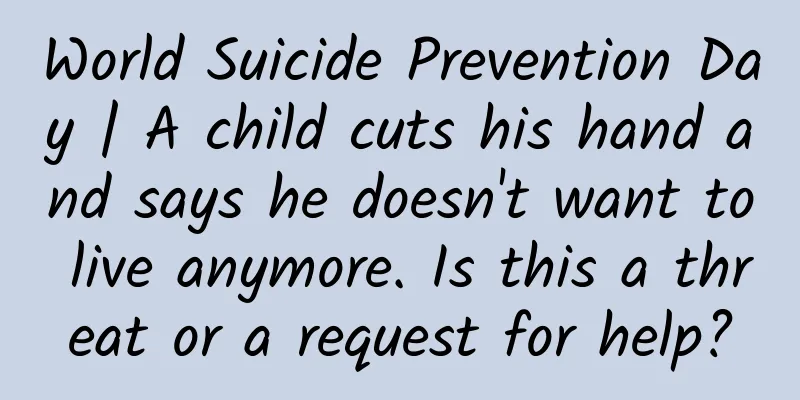World Suicide Prevention Day | A child cuts his hand and says he doesn't want to live anymore. Is this a threat or a request for help?

|
Author: Qian Hong: Doctor of Medicine, Attending Physician, Intermediate Psychotherapist, Department of Child Health, Tongji Hospital, Tongji Medical College, Huazhong University of Science and Technology Xu Yungang Department of Child Health, Tongji Hospital, Tongji Medical College, Huazhong University of Science and Technology Duan Wei Department of Child Health, Tongji Hospital, Tongji Medical College, Huazhong University of Science and Technology Reviewer: Hao Yan, Chief Physician of Tongji Hospital affiliated to Tongji Medical College of Huazhong University of Science and Technology In the psychological clinic, a couple of parents came with their children... The parents said firmly: "Doctor, the child cut his hand at home and said he didn't want to live and threatened us. He just didn't want to go to school and wanted to play with his phone. In fact, the child is just lazy and always playing with his phone. As long as we return the phone to the child, his mood will be better." During the consultation, the child sometimes kept silent with his head down, sometimes cried silently, and in a hurry he would shout: "I am not happy playing with my phone, I just don't want to go to school, I feel that life is meaningless!" Figure 1 Copyright image, no permission to reprint 1. Are children really threatening their parents? When children self-harm and say things like "I don't want to live anymore," it's not simply a threat or a call for attention, but a signal for help. They may be experiencing severe emotional distress or stress. Every suicide is a tragic event, especially when the deceased is a child. It is not only the relatives and friends of the deceased who feel heartbroken and sad, but also the general public. Therefore, preventing children from committing suicide is not only extremely important for families, but also one of the issues that society must prioritize. 2. Understanding Suicide Do you all know? According to statistics from the World Health Organization (WHO), more than 700,000 people die from suicide every year (one person dies from suicide every 40 seconds)[1]. In 2016, the number of deaths from suicide worldwide reached 817,000, and suicide was the fourth leading cause of death among people aged 15 to 29[2]. The detection rate of non-suicidal self-injury (NSSI) among Chinese adolescents is as high as 25%, with girls slightly higher than boys[3]. The "China National Mental Health Development Report (2021-2022)" shows that in China, 14.8% of adolescents are at risk of depression to varying degrees, of which 4.0% are at risk of severe depression[4]. Regardless of the problem, the feelings and thoughts of suicidal people are often similar. (1) Feelings: Sad, miserable, lonely, helpless, hopeless, and worthless. (2) Thoughts: “I wish I could die,” “I can’t do anything,” “I can’t take this anymore,” “I’m a loser,” “I’m a burden,” “Others would be happier without me.” Figure 2 Copyright image, no permission to reprint 3. Myths and truths about suicide Myth 1: Children who talk about suicide are just threatening or trying to get attention. Truth: Children who talk about suicide may be sending a signal for help, and we should take it seriously. Myth 2: Talking about suicide will trigger suicidal behavior. Truth: The right conversation can help a suicidal person reduce anxiety and provide him or her with more options. Myth 3: Suicide only occurs in a certain group of people and children will not commit suicide. Truth: People of any age can be at risk of suicide, especially when facing stress. Myth 4: Suicide is usually sudden and has no signs. Truth: Before committing suicide, people usually have obvious changes in mood and behavior. Myth 5: Suicide is a personal choice and cannot be prevented. Truth: Suicide can be effectively prevented through a variety of measures, such as limiting the accessibility of suicide methods, responsible media coverage, developing life skills for young people, and early identification and management of those at risk of suicide. 4. How to identify the signs of suicide in children? (1) Mood changes: becoming anxious, depressed, and desperate. (2) Behavioral changes: decline in academic performance, loss of interest, and social withdrawal. (3) Verbal cues: talking about the topic of "death or suicide". (4) Dangerous behavior: self-harm or risky behavior. (5) Gifting: Giving gifts to others for no reason. (6) Life events: experiencing family changes or increased pressure from school. Figure 3 Copyright image, no permission to reprint 5. How to respond correctly to children’s self-harm or suicidal behavior (1) Take it seriously: When children indicate that they are experiencing emotional distress, parents should take their children’s words and actions seriously. (2) Open communication: Create an open, non-judgmental communication environment for children. (3) Express concern: Let children know that their family and friends care about them and are willing to support them. (4) Avoid blaming: Avoid criticizing or blaming children, as this may exacerbate their negative emotions. (5) Safety measures: Remove dangerous items from the home to reduce the risk of children harming themselves. (6) Seek help: Seek professional mental health services in a timely manner. Figure 4 Copyright image, no permission to reprint Suicide is preventable, and the first step to prevention is to take children's words and actions seriously. Through the joint efforts of families, schools and society, we can create a safer, mutually understanding and supportive growth environment for children. Let us protect children's growth path together and let them feel that this world is full of warmth and hope! References: [1]World Health Organization. Suicide prevention. http://www.who.int/mental_health/suicide-prevention/en/ [2]Collaborators GSH, Kumar M, Lorkowski S. Global, regional, and national burden of suicide mortality 1990 to 2016: Systematic analysis for the Global Burden of Disease Study 2016[J]. BMJ (online), 2019, 364 (194). DOI: https://doi.org/10.1136/bmj.l94. [3] Tao Mengyang, Feng Longfei, Guo Fei, et al. Meta-analysis of the detection rate and influencing factors of non-suicidal self-injury in Chinese adolescents[J]. Journal of Guangxi Medical University, 2023, 40(10): 1627-1634. DOI:10.16190/j.cnki.45-1211/r.2023.10.005. [4] Fu Xiaolan, Zhang Kan. China National Mental Health Development Report (2021-2022)[M]. Beijing: Social Sciences Academic Press, 2023. |
Recommend
What medicine is good for leucorrhea? Experts recommend a good prescription
Women's leucorrhea has a special function. If...
4 months pregnant woman suddenly has severe back pain
Pregnant women are bound to suffer from back pain...
The reason why women have heavy beards is
Men grow beards but women do not. Some female fri...
Don’t wait until your teeth rot before you regret it! How to protect your teeth? Experts suggest...
It's the start of another school year. For ma...
What to do if a woman has severe uterine prolapse
Gynecological diseases are a type of disease with...
What does chronic cervicitis mean?
Cervicitis is one of the common gynecological dis...
Can I eat arugula during my period?
Diet is very important to us humans. In ancient t...
How to lose weight safely while breastfeeding
Many women gain a lot of weight after pregnancy b...
Are benign uterine fibroids serious? What can they cause?
For many women, uterine fibroids are a very commo...
Traditional Chinese medicine treatment and conditioning of functional constipation in the elderly
What is constipation and what are the causes of c...
What to do if you have diarrhea at 50 days of pregnancy
Many women experience diarrhea when they are 50 d...
How painful is it for a woman to give birth?
Women are very afraid of pain. It can be said tha...
"Children, don't be greedy, after Laba Festival it will be the New Year." Here is the detailed guide to Laba porridge!
Laba Festival is coming soon. After Laba Festival...
Can pregnant women eat eels in the early stage?
Many people know that eel is a good thing for nou...
Can I induce abortion if I am already seven months pregnant?
The pregnancy is already seven months, which can ...









